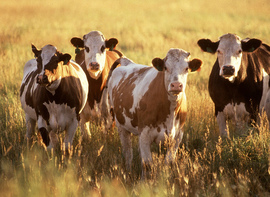|
Having trouble viewing this email? View it as a Web page.

|
|
|
Fresh from the Field is a weekly album showcasing transformative impacts made by grantees supported by the National Institute of Food and Agriculture.
Editor: Falita Liles Feb.1, 2018
|
|
Success Stories

Saving
Ranchers Money
Glenn Shewmaker, professor
at the University of Idaho, wants to help ranchers save money. According
to Shewmaker, livestock producers who implement managed grazing practices could
see increased carrying capacity of pastures, extended grazing seasons, and
reduced winter feed costs.
Increasing carrying
capacity could reduce annual cow production cost by up to $100/cow. For a
typical ranching operation of 350 cows, this could represent an annual savings
of $35,000.
NIFA support this project
through the Sustainable Agriculture Research & Education Program.
Read the full
article at Western SARE. USDA photo by Keith Weller.
|
News Coverage

Weed Less, Grow More with Mulch
Gardeners may improve
their soil and weed control with organic mulch, according to research at Michigan
State University’s (MSU) Extension Office. Mulch
can be used in nearly every garden setting to prevent weeds from growing.
Prevention is the best defense against a weedy garden. Mulch may smother annual
weed seeds and reduce or eliminate cultivation, hand weeding, and chemical weed
control, while contributing beneficial organic matter.
An MSU study demonstrated
that organic mulch regulates soil temperatures by as much as 18 degrees at
mid-day, which allows moisture levels to remain more consistent and diminishes
moisture losses. A caution, though: Mulching may decrease the need for
watering, but does not eliminate it.
NIFA supports the research
with the Crop Protection and Pest Management Program.
Read the full
article at MSU Extension. Photo courtesy of Bert Cregg, MSU.
|
The Library

Controlling
Feral Swine
Feral swine cause
thousands of dollars in damage to landscaping, vegetable and fruit crops,
underground irrigation systems, and spread bacteria to livestock in Texas. Wild
hogs occasionally prey on livestock, especially newborn lambs, goats, and
calves. The feral swine population in Texas has been estimated at 2.6 million –
and could grow tremendously, as one sow can reproduce more than 40 piglets in
one year.
Research and Extension
agents at Prairie View A&M University (PVAMU) preliminary findings indicate savings on average of
$11,000 per year in property damage for producers and landowners when feral
swine are used for human consumption.
NIFA supports this project
through Agricultural Extension Programs at 1890 Institutions.
Read the full
article at PVAMU. USDA photo.
|
Video
 Making
a Difference with Youth Nutrition
The Expanded Food and Nutrition Education Program (EFNEP) is a NIFA-funded nutrition education program established in 1969
to serve the needs of low-income families and school-aged youth. Operated
through the land-grant university system and Cooperative Extension, EFNEP
extends the research of the universities to our most needy families to improve
their nutrition, overall health, and quality of life. In North Carolina, EFNEP
is administered through NC State University and NC A&T State
University.
Watch the video
from the North Carolina Cooperative Extension. USDA photo by Lance Cheung.
|
Tweet of the Week
#NIFAIMPACTS

|
|

NIFA’s mission is to invest in and advance agricultural research, education, and extension that solve societal challenges. NIFA’s investments in transformative science directly support the long-term prosperity and global preeminence of U.S. agriculture. To learn more about NIFA’s impact on agricultural sciences, visit www.nifa.usda.gov/Impacts, sign up for email updates or follow us on Twitter @USDA_NIFA, #NIFAImpacts.
USDA is an equal opportunity lender, provider, and employer.
|
|